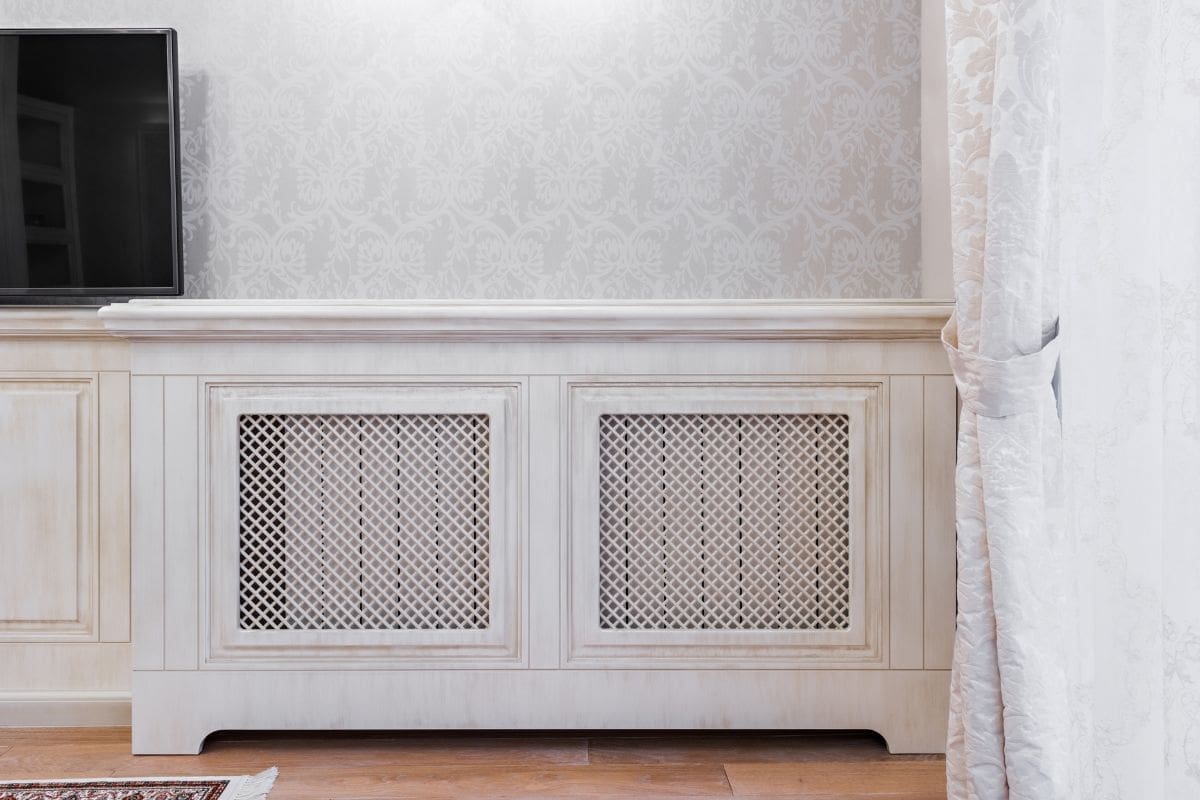As a typical heating appliance, radiators are not there simply to look pretty but to keep your home warm using natural convection.
However, with more emphasis on interior design, these appliances can prove unsightly and distract from the rest of the carefully plotted aesthetics of a room.
To align a radiator to the design of the rest of your room, you can cover one up though this does come with implications for the heating.
In this guide, we will look at what a radiator cover is, why you may consider getting one, whether radiator covers block heat, and how to boost the efficiency of your radiator.
What A Radiator Cover Is
A radiator cover is essentially a means of covering up a radiator to obscure it from view. They typically come in two materials, wood and galvanised metal.
Wood is considered the most common material for a radiator cover as it simply looks better. This is despite the fact that wood is not a great conductor of heat but it is good for childproofing so is ideal for a young family.
Wooden radiator covers tend to have gaps and lines across them to allow the heat to come through. Alternatively, galvanised metal is an excellent heat conductor so should prevent sizable heat loss.
The drawback with galvanised metal is that it lacks childproofing as the heat will come through so children can still suffer from burns if they come in contact with the cover.
If you do decide to buy a radiator cover, considering the material is key to ensuring it remains safe to have in your home.
Radiator covers have come in vogue due to how they can align the heating appliances with your home aesthetic.
Should your room be decorated in a certain colour then you should find a wooden cover to match it, or simply paint it yourself as a fun DIY project.
The customisable aspect of radiator covers can bring a freshness to a living space, as well as keep children safe from burning themselves.
Why You May Consider A Radiator Cover

Several reasons exist for why having a cover for your radiator may be a worthwhile decision.
Not only can they childproof the appliance and add an aesthetically pleasing design, but a radiator cover can also add extra storage space, particularly in the bathroom.
With a flat surface, you should be able to store soaps and fragrances to keep them within easy reach. By repurposing the space, the radiator cover can become a makeshift mantelpiece.
Do Radiator Covers Block Heat?
Whenever you add a layer of material or an object onto or near a heated appliance, you are preventing the full capabilities of the heat emission.
That is certainly the case with radiator covers and they can limit the efficiency of your central heating system.
By interrupting the flow of warm air and the natural convection, you can suffer heat loss and reach for the thermostat when you really should not have to.
Effectively, a radiator cover can cost you money by excessively spending on heating you are not enjoying.
How To Boost The Efficiency Of Your Radiator
While it is apparent that a radiator cover would weaken the heating appliance’s efficiency, there are other ways to boost its effectiveness. These include bleeding the radiators, applying reflective backing, and maintaining a gap for the radiator.
Bleeding The Radiators
Most households should be bleeding their radiators at least once a year. The task helps to remove any trapped air which could be preventing the hot water from getting around the appliance.
It also only takes a minute or so to bleed a radiator and is a sure-fire way to boost its efficiency.
Reflective Backing
To help the convection process, you could install reflective backing directly behind the radiator to assist the heat back into the room and prevent it from being absorbed into the wall.
Maintain A Gap
Radiators work by natural convection, as cold air sinks to the bottom of the wall, it comes into contact with the radiator then heats up and rises as the air becomes less dense.
The warm air effectively heats up a room. However, if you were to put objects next to the radiator, such as a sofa, or surround one with a radiator cover, then this would interfere with the natural convection and you would not be able to feel the full benefits of the heating.
Final Thoughts
Whether you buy a radiator cover largely depends on how highly you value the aesthetic in your home.
Radiator covers may be a good option if you have young children running around and need a means of preventing them from burning themselves on the hot surface.
While a cover should look good to hide a radiator, any material that obstructs a heating appliance will reduce its effectiveness.
Frequently Asked Questions
Should A Radiator Cover Go Over The Valves?
To provide a complete design, the radiator cover should go over the valves, as well as the heater and pipes.
Before you do buy a radiator cover, you should measure the dimensions of your radiator then add around five centimeters on each side to account for the pipes and valves.
Allowing for the valves and pipes should provide a good fit for your radiator cover.
Does A Sofa Placed In Front Of The Radiator Block The Heat?
Any item or material placed in front of or on a heating appliance will harm how it heats a room. When you are planning to move furniture or invest in a new sofa, it is a good idea to give your radiator some room.
Large pieces of furniture would block the heat from travelling effectively across the room and over time you may see your bills go up. Also, the piece of furniture itself may be damaged due to long-term exposure and proximity to the radiator.